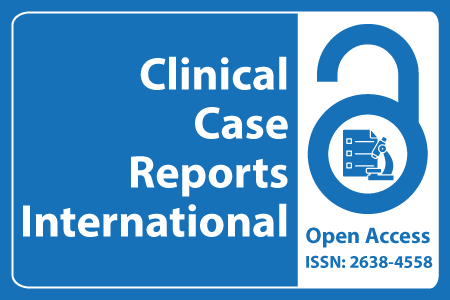
Journal Basic Info
- Impact Factor: 0.285**
- H-Index: 6
- ISSN: 2638-4558
- DOI: 10.25107/2638-4558
Major Scope
- Internal Medicine
- Oncology
- Surgical
- Orthopedic Sugery
- Neonatology
- Hepatitis
- Hypertension
- Breast Neoplasms
Abstract
Citation: Clin Case Rep Int. 2018;2(1):1051.DOI: 10.25107/2638-4558.1051
Misdiagnosing Epilepsy: A Case Report on Stokes - Adams Syndrome
Roshanee Seth, Deepak G Mishra and Sushant Chhabra
Department of Accident and Emergency, Leicester Royal Infirmary, UK
Department of Emergency Medicine, Hamad Medical Corporation, Qatar
Department of Emergency Medicine, Manipal Hospital, India
*Correspondance to: Sushant Chhabra
PDF Full Text Case Report | Open Access
Abstract:
Introduction: Epilepsy is a common neurological disorder prevalent among 7 out of 1,000 people in general population. (1) Before determining whether paroxysmal events represent an epileptic disorder, one must consider 2 alternatives: (a) non epileptic events mimicking epileptic seizures and (b) true epileptic seizures caused by a non-neurological condition. We report a patient with a complete Atrioventricular (AV) block presenting with misleading symptoms suggesting seizure.Case
Presentation: A 76-year-old, male, received at home, with a history of collapse and multiple episodes of ongoing unusual jerky movements of the body and amnesia to current events, no post ictal confusion. The vital signs measured at home were: blood glucose: 279 mg/d, Heart Rate (HR)-36/min, respiratory rate: 10/min, blood pressure-80/60 mm hg.Management and Outcome: In view of recurrent seizures and unstable bradycardia patient was managed with injection atropine 0.6 mg IV bolus, injection Midazolam 2 mg IV bolus, injection Phenytoin 1 gm IV loading dose and external cardiac pacing on demand mode (30/70). Patient continued seizing, with decreased level of consciousness. In view of low Glasgow Coma Scale (GCS) and risk of aspiration, patient was intubated and mechanically ventilated, shifted to cath lab for temporary pacemaker implantation and was planned for permanent pacemaker and coronary angiography, transferred to the Cardiac Care Unit for further monitoring and stabilization. Coronary angiography reported Triple Vessel Disease (TVD). 2nd day of hospitalization, patient was extubated, maintained all vital signs and was neurologically intact.
Discussion: This study points to the difficulty one faces in confusing seizure with syncope and vice versa during diagnosis. Hence, reinforcing the importance of differentiating one from the other, recognizing repeated, convulsive syncope’s without provocation with a normal sinus rhythm or any other rhythm disturbance, are suggestive of cardiac syncope. Such patients should have a cardiac evaluation before discharge and stress should be laid on noninvasive cardiovascular evaluation such as Holter ECG monitoring, especially in patients with infrequent attacks and less dramatic rhythms.
Keywords:
Cite the Article:
Seth R, Mishra DG, Chhabra S. Misdiagnosing Epilepsy: A Case Report on Stokes - Adams Syndrome. Clin Case Rep Int. 2018; 2: 1051.













